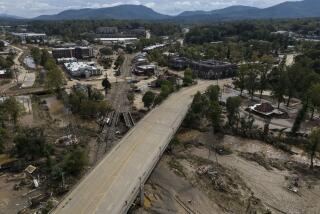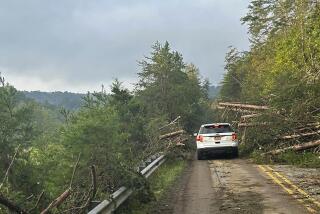Frances Staggers a Weary Florida
- Share via
STUART, Fla. — Hurricane Frances swamped the entire Florida peninsula Sunday, leaving at least two people dead and 2.1 million homes and businesses without power. Some communities were doused with as much as 17 inches of rain over the weekend.
The storm appears to have spared the state the full-force hit many had predicted.
Still, Frances isn’t done. It was expected to move over the Gulf of Mexico this morning, where it is likely to regain strength before striking the Florida Panhandle near Apalachicola Bay. Evacuation orders were in effect Sunday night in four Panhandle counties, even as Frances was downgraded to a tropical storm.
As the storm made its way across Florida, it left behind a chaotic and topsy-turvy world: boats in parking lots, part of an interstate swallowed by a sinkhole and crabs skittering through sand-filled waterfront neighborhoods, mistaking them for beaches.
Much of Florida was a soggy, stifling mess littered with uprooted pine and ficus trees, shredded billboards, flattened street signs and mangled traffic lights.
“There is not a corner of this state that wasn’t impacted by this storm,” said Max Mayfield, director of the National Hurricane Center in Miami.
Having gone through two hurricanes, Frances and Charley, and Tropical Storm Bonnie in the space of a month, this state is simply spent. And the National Hurricane Center reported Sunday that another hurricane, Ivan, had formed in the Atlantic and was making a run toward Florida.
Ivan was classified as a Category 4 hurricane by Sunday night, with sustained winds of 135 mph, and growing. It is expected to rake the Windward and Caribbean islands this week. Officials suggested that homeowners might not want to bother taking down protective storm shutters.
“People are tired,” said Michael D. Brown, director of the Federal Emergency Management Agency. “They’ve survived one damaging hurricane and are enduring a second with another storm looming on the horizon.”
Gov. Jeb Bush sounded almost resigned to the arrival of Ivan.
“We’ll take it on,” he said. “We’re a resilient state.”
Two storm-related deaths had been reported by Sunday night: a man killed in a car accident near Gainesville and a woman who died when an oak crashed onto her mobile home. Officials in eastern counties cautioned, however, that they were only beginning to access and assess some of the worst-hit communities.
Frances came ashore shortly after midnight Sunday at Sewall’s Point, a spit of sand east of Stuart and north of Palm Beach that is part of Florida’s Treasure Coast.
The storm, which lumbered northwest about 10 mph, was such a large system that at one point hurricane warnings were in effect for the east and west coasts of the state.
By nightfall Sunday, Frances had moved over the interior of Florida and reached the Tampa Bay area, weakened to the point that it was downgraded to a tropical storm with sustained winds of 65 mph, down from about 105 mph when it first struck land.
In Franklin County -- which includes Apalachicola Bay, a quiet waterfront community known for its commercial fishing and passion for oysters -- “we’re going crazy,” said emergency management representative John Szafranski.
The area was among those hit last month by Tropical Storm Bonnie, but “Bonnie was a drop in the bucket compared to this,” Szafranski said. Bridges to island and waterfront communities were only open in one direction.
“You can get out, but you can’t get in,” he said.
On the east coast of Florida, wind damage was widespread but few large structures appeared to have been destroyed. Some of the 2.8 million people who fled as Frances approached began returning home Sunday, and many were surprised to find their homes standing.
Ginette Ball, 34, of Port St. Lucie lost a wooden fence, a tree and a pool screen, but her three-bedroom, two-bathroom wood-frame house was fine.
“I was incredibly thankful,” she said as she prepared a spaghetti dinner on the porch, using a gas-powered barbecue because she had no electricity. “I was expecting not to have a roof.”
Floodwaters that began to pool Sunday, more than 4 feet deep in some neighborhoods, remained the most worrisome aspect of Frances, officials said.
In several communities, debris left by Hurricane Charley three weeks ago was still piled in streets and yards when Frances hit. That debris has been swept over storm drains, which means swampy regions that often have trouble draining away rainwater could see lasting flooding.
“It’s blocking everything. That’s the biggest thing we’re dealing with,” said Lauren Hames, a spokeswoman for the city of Orlando, which was walloped by Charley and Frances. “We thought we had it hard enough with Charley. At this point we’re just trying to hang on. We’re just doing the best we can.”
Brown, the FEMA director, flew from the state capital of Tallahassee with Bush on Sunday afternoon in a C-130 National Guard transport plane. The craft had descended to 2,000 feet while approaching West Palm Beach, just south of Frances’ primary strike zone, when Brown looked out the window and saw a lake stretching as far as he could see.
“I asked the governor, ‘Are those the Everglades?’ And he said, ‘No, those are a lot farther south,’ ” Brown said. “That’s how much water was already out there.”
The huge amount of water coursing through the state appears to have been the culprit behind a sinkhole that opened up on Interstate 95, officials said.
The hole, in Palm Beach County, had devoured the outside northbound lane and was growing Sunday night. State officials were forced to close all northbound lanes of the highway and cautioned that southbound traffic could soon be affected too.
Several other roads were broken apart in the storm. They included portions of Indian River Drive, a main access road between Jensen Beach and Fort Pierce. John Davenport, 41, a restaurant manager, rode out the hurricane alongside the road. He lives in an 80-year-old shack on an old pineapple plantation with his beagle, Chance.
“I just watched the road disappear,” he said. “It just ate it up.”
In West Palm Beach, Gene Dumette tried to escape rising water on Spencer Drive by pulling into a parking lot, only to run into deeper water that rose over the hood of his silver Corvette and seeped through the doors. On Sunday night, he was busy mopping out his car with a cloth while a friend bailed it out with an empty antifreeze bottle.
“That’s Florida life for you,” Dumette said with disgust.
Floodwaters remained dangerous, Mayfield said, because downed power lines scattered through the state made electrocution possible. And with widespread power outages -- 2.1 million homes and businesses were still without power Sunday night, officials said -- Mayfield said he feared that people would light candles that could start house fires.
“I’m afraid people will die,” he said. “I can almost guarantee it.”
Authorities said many homes might not get power back until the end of the week.
A massive rescue mobilization began Sunday and will be in full swing today. FEMA and American Red Cross officials said they expected to deliver their largest response ever to a natural disaster in the coming days. Thousands of National Guard troops were expected to be mobilized as well.
Red Cross spokesman Peter Teahan said that 1,700 volunteers, many of whom had helped the state cope with Charley, were again set to roll out of their headquarters in Bradenton, south of Tampa. Another 3,300 Red Cross workers were at a staging area in Atlanta, where they planned to fan out today with 42 mobile kitchens and another 250 trucks and vans full of meals and personal hygiene articles.
For many Florida counties, the rescuers cannot arrive soon enough. Frances stalled for two days before hitting shore, but after many evacuation orders were given. That means many packed shelters will have been open for five days as of this morning.
“We are running low on food in all of our shelters,” said St. Lucie County Administrator Doug Anderson.
President Bush, the governor’s brother, has declared Florida a major disaster area and has ordered federal aid to supplement local recovery efforts. In a brief phone conversation Sunday, the president assured the governor that federal aid was in place, a White House spokesman said.
Preliminary damage estimates had not been completed Sunday. But officials said Frances probably would not approach Charley, which killed 27 people and caused $7.4 billion in insured damage. But the tab for Frances will be high: Wind and water damage to St. Lucie County International Airport alone could be $100 million, Anderson said.
Florida farmers also were fretting Sunday about potential losses. The state is home to 19,000 farms and 5.7 million acres of land used to feed livestock and grow crops such as oranges and grapefruit. Charley already had destroyed 20% of the orange crop, at a cost of $250 million; Florida’s $10-billion nursery industry was expected to take a big hit this time around.
“It’s too early to tell how much damage we’ll suffer,” state government spokesman Tom Bottcher said. “But Florida is a big agricultural state, and much of that land [was] in the path of Frances.”
Gov. Bush issued an executive order Sunday diverting gasoline supplies to emergency vehicles. The order puts police cars, ambulances and other “first responders” at the front of the line for available gas, Lt. Gov. Toni Jennings said.
A gas shortage last week contributed to extensive travel delays during the Frances evacuation. But state officials said barges ferrying gas from Texas and Louisiana were on the way to Tampa, with the fuel to be distributed throughout the state.
Two bright spots could be found emerging from Frances: babies born in the thick of it.
In Stuart, 23-year-old Amanda Jones went into labor a week early at the Suburban Lodge motel, where she had checked in to ride out the storm. Six-pound, two-ounce Maranda was delivered by a midwife who happened to be staying there.
In Palm Beach County, a 28-year-old woman called 911 at 2:16 a.m. Sunday -- during the height of the storm -- to report that she was in labor. Rescue vehicles were unable to get to her house because of high winds, so dispatcher Jill Anderson stayed on the phone with the woman’s father for more than an hour and talked him through the delivery, Palm Beach Fire and Rescue Capt. Don DeLucia said.
“They just went step by step,” he said.
The baby, who is healthy, was named Frances.
Glionna and Dahlburg reported from Florida and Gold from Houston. Times staff writers David Colker and Chris Gaither in Florida, Lianne Hart in Houston and Maura Reynolds in West Virginia contributed to this report.
More to Read
Sign up for Essential California
The most important California stories and recommendations in your inbox every morning.
You may occasionally receive promotional content from the Los Angeles Times.














